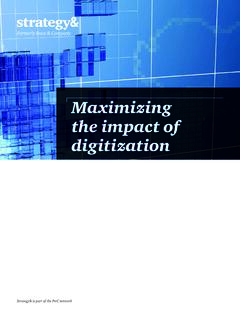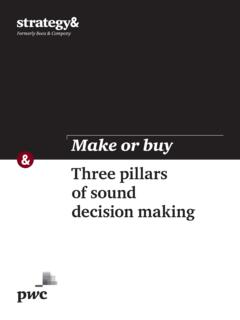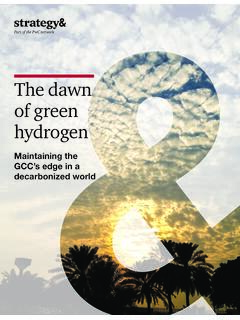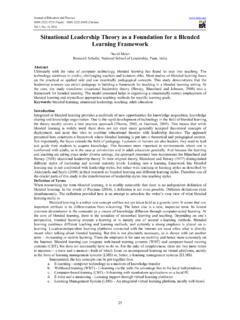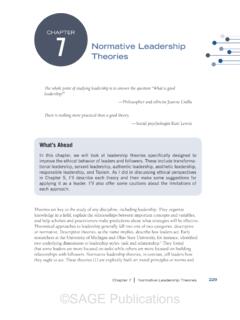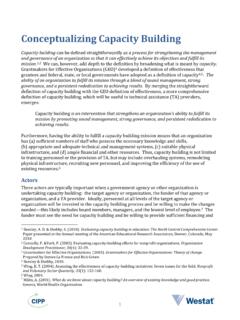Transcription of Ten guiding principles of change management - Strategy&
1 Ten guiding principles of change management2 Strategy&ContactsChicagoGary NeilsonSenior Partner+ TippingPartner+ rg KringsPartner+ FranciscoDeAnne AguirreSenior Partner+ report was originally published by Booz & Company in guiding principles of change managementSuccess at large-scale transformation demands more than the best strategic and tactical plans, the traditional focus of senior executives and their advisers. It requires an intimate understanding of the human side, as well the company s culture, values, people, and behaviors that must be changed to deliver the desired results. Plans themselves do not capture value. Value is realized only through the sustained, collective actions of thousands or tens of thousands of employees who are responsible for designing, executing, and living the change . Long-term structural transformation is characterized by scale it affects all or most of the organization; by magnitude it involves significant alterations from the status quo; by duration the change program lasts for months if not years; and by its strategic importance.
2 Yet companies will reap the rewards only when change occurs at the level of the individual senior executives recognize this, and it worries them. When asked what keeps them up at night, CEOs often wonder about how the workforce will react, getting my team to work together and pull this off, leading my people through this, retaining our unique values and sense of identity, or creating a culture of commitment and performance. leadership teams that fail to plan for the human side of change often find themselves wondering why their best-laid plans go awry. Strategy& has partnered with dozens of companies to plan and execute sweeping change . Through the course of these engagements, we have developed a unique perspective on managing the human side of change . No single methodology fits every company, but a set of practices, tools, and techniques can be adapted to a variety of situations. With these as a systematic, holistic framework, we can help executives understand what to expect, how to manage their own personal change and how to engage the entire organization in the process.
3 What follows is our Top Ten list of guiding principles for transformational ) Address the human side of change systematically: Any transformation of significance will create people issues. New leaders will be asked to step up, jobs will be changed, new skills and capabilities must be developed, and people will be uncertain and will resist. Dealing with these issues on a reactive, case-by-case basis puts speed, morale, and results at risk. A disciplined approach to change management must be one of the four pillars of any transformation approach (see Exhibit 1, next page). This fact-based approach demands as much data collection and analysis, planning, and implementation discipline as a redesign of strategy, systems, or processes. It should be fully integrated into program design and decision-making, both informing and enabling strategic direction. It should be based on a realistic assessment of the organization s history, readiness, and capacity to change .
4 And it should link multiple change initiatives together. A formal approach for managing change beginning with the leadership team and then engaging key stakeholders and leaders should be developed early but adapted often as change moves through the ) change starts at the top and begins on day one: change is inherently unsettling for people at all levels of an organization, and when it is on the horizon all eyes will turn to the CEO and the leadership team for strength, support, and direction. The leadership must change first to challenge and motivate the rest of the institution, speaking with one voice and walking the talk to model desired behavior. At the same time, individual executive team members are going through their own personal changes and need to be supported so that they can be in agreement with their executive team members. Executive teams that work well together, that are aligned and committed to the direction of change , that understand the culture and behaviors it intends to introduce, and that can model those changes themselves are best positioned for example:The senior team of a large consumer services company rolled out an initiative to improve the efficiency and performance of its corporate and field staff before addressing change issues at the officer level.
5 The initiative realized initial cost savings but stalled as employees began to question the leadership team s vision and commitment to the change managers didn t embrace the program, not wanting to take risks until they the direction and permanence of the initiative were clear. Only after the leadership team went through the process of aligning and committing to the change initiative was the workforce able to deliver downstream example:A major multi-line insurer with consistently flat earnings determined that it needed to change performance and behavior to prepare for going public. It followed the cascading approach to change , training and supporting teams at each stage: 10 officers setting the strategy, vision, and targets; 60-80 senior executives and managers designing the core of the change initiative; 500 leaders from the field getting the details right and driving implementation. This structure remained in place throughout the change program, which doubled earnings far ahead of 1 Opportunity definitionDefine problem, set vision, and size the prizeDefine problem, set vision, and size the prizeEngage the top and lead the changePhase 2 Design and planningCascade down and break barriersDrive design teams to meet the numbersTranslate vision into specific, actionable strategiesDesign the modelProcessIT systemsOrganizationPlan the implementationPhase 3 ImplementationMeasure, track, and hold field accountableMobilize the base and create ownershipDetail design where requiredAdapt to implementation realitiesStrategy Decide Capability building Design Program management Drive Changemanagement Deploy Exhibit 1 Comprehensive strategy-based transformation approachSource: Strategy&6 Strategy&3) Real change happens at the bottom.
6 As transformation programs progress through strategy/target setting, design, and implementation, they affect different levels of the organization. change efforts must include plans for identifying leaders and pushing responsibility for design and implementation down through the organization (see Exhibit 2). Strategy and target setting is usually the responsibility of the leadership team and its direct reports. Design teams drawn from the next layer of executives and senior managers must be prepared to work across silos and lead the change . Implementation relies on line managers and individual contributors. Each of these layers must have identified, trained leaders who are aligned to the company s vision, equipped to execute their specific mission, and motivated to make change happen. These change leaders must be released from their current assignments and dedicated to the work of change . 4) Confront reality, demonstrate faith, and craft a vision: Individuals are inherently rational and will question to what extent change is needed, whether the company is headed in the right direction, and whether they want to personally commit to making change happen.
7 They will look to the leadership for answers. Articulating a formal case for change and creating a written vision statement are invaluable opportunities to create (or force) leadership team alignment. Leaders Engage the top and lead the change Cascade down and break barriers Mobilize the basisand create ownership 123 Build leadership teamEstablish case for change and craft visionConduct cultural diagnosticBuild change elements into program designIdentify and empower key change agentsCreate cross-functional teamsDesign organization-wide change programRoll out communications planRoll out change program at the baseMeasure changeEmbrace learning and knowledge sharingProvide needed training and supportFacilitate bottom-up and top-down communication Exhibit 2 Cascading ownershipSource: Strategy&7 Strategy&must then customize this message for various internal audiences, describing the pending change in terms that matter to the individual (see Exhibit 3).
8 Confronting reality and articulating a compelling need for change Demonstrating faith that the company has a viable future and the leadership to get there Providing a roadmap to guide behavior and decision-making5) Create ownership, not just buy-in: Large change programs require a distributed leadership that has broad influence over decisions both visible and invisible to the senior team (see Exhibit 4, next page). Cha nge leaders must over-perform during the transformation and be the zealots that create critical mass for change in the workforce. This requires more than mere buy-in or passive agreement that the direction of change is acceptable. It demands ownership by leaders willing to accept Client example:A consumer packaged-goods company experiencing years of steadily declining earnings determined that it needed to significantly restructure its operations to remain competitive, shedding upwards of 30% of the workforce in the process.
9 The leadership team s challenge was to shift the focus from the massive downsizing and engage the survivors in embracing the new business strategy. Through a series of offsite meetings, the executive team built a brutally honest business case that downsizing was the only way to keep the business viable and drew on the company s proud heritage to craft a compelling vision to lead the company forward. By confronting reality and helping employees understand the necessity for change , the leadership was able to motivate the organization to follow the new direction in the midst the largest downsizing in the company s h i s tor reality2 Demonstrate faith3 Articulate vision Confront the most brutal facts of the current situation * Retain faith that you will prevail in the end regardless of difficulty * Explain where you are going and what you need to do to get there Exhibit 3 change leaders message to the institution*J. Collins, Good to Great, Harper Collins, 2001 Source: Strategy&8 Strategy&responsibility for making change happen in all of the areas they influence or control.
10 Ownership is often best created by involving people in identifying issues and crafting solutions. It is reinforced by a combination of tangible (financial compensation) and psychological (camaraderie, sense of shared destiny) incentives and rewards. Many companies create design and build teams led by key change agents to develop the core strategies they will need to implement. Middle and line managers are likewise engaged in Phase III of the change program to flesh out the detailed implementation plans that they will ) Practice targeted over-communication: The best-laid plans are only as good as the institution s ability to understand, adopt, and act on them. Too often, change leaders make the mistake of believing that others understand the issues, feel the need to change , and see the new direction as clearly as they do. The best change programs reinforce core messages through regular, timely advice that is both inspirational and actionable.



